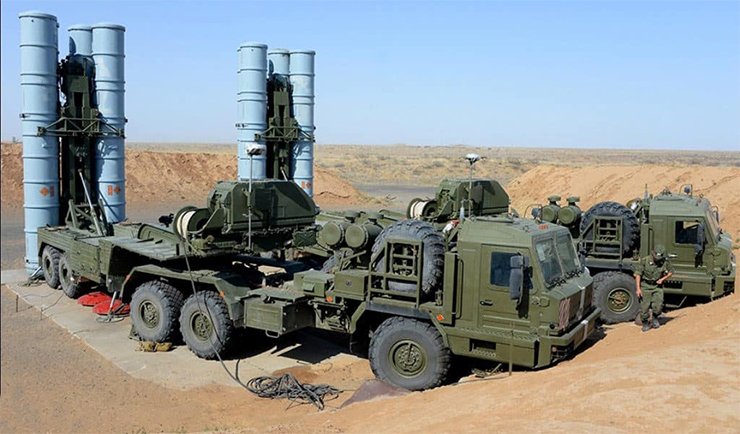Iran is reconciling with the impact of damage to its air defences as the result of the recent Israeli airstrikes, which targeted Iran’s critical military infrastructure, highlighting Israel’s intention to mitigate perceived threats and limit Iran’s missile capabilities. It was a tactical strike with a strategic messaging. According to US and Israeli intelligence, Israel focused on eliminating Iran’s integrated air defence networks and systems, among other strategic targets, making it further vulnerable to future strikes. Does it mark a strike to de-escalate or escalate is to be seen?
Strategic Implications of Targeting Iranian Air Defences
The airstrike’s immediate objective was to neutralise Iran’s most advanced S-300 air defence systems. Long-range surface-to-air missile systems, including Tehran’s prized Russian-made defence assets, were reportedly among the primary targets. These systems have long been critical to Iran’s layered defence strategy, capable of intercepting both aircraft and ballistic missiles. Analysts suggest that targeting these systems weakens Iran’s ability to defend against future airstrikes, potentially leaving key military and infrastructure sites vulnerable. This tactical advantage has strategic payoffs and allows Israel not only to inhibit Iran’s immediate military capabilities but also to dissuade Tehran from launching further missile offensives.
Long-term Impact of Targeting Iran’s Critical Infrastructure
Israeli airstrikes targeted Iran’s critical infrastructure, including military installations and energy sites and caused substantial damage. Satellite imagery reveals extensive damage to several key Iranian military and industrial sites following Israel’s recent airstrikes. At the Parchin complex, a known missile production facility previously linked to nuclear activity, at least four buildings, including the Taleghan 2 site, appear significantly damaged. Images from the Khojir complex, Iran’s central hub for ballistic missile infrastructure, and Shahroud, a long-range missile production site, also show substantial impact. The Nakhjir radar site, a recently updated radar defence installation, was also reportedly targeted. Damage to a storage unit at the Abadan oil refinery in Khuzestan Province highlights Israel’s strategic reach, affecting critical energy infrastructure.
Israel’s objective was to neutralise Iran’s most advanced S-300 air defence systems. Long-range surface-to-air missile systems, including Tehran’s prized Russian-made defence assets, were among the primary targets. These systems have long been critical to Iran’s layered defence strategy, capable of intercepting aircraft and ballistic missiles
The Role of Russian-Made Air Defence Systems
The Russian-made S-300 defence systems that Tehran relied upon were relatively advanced, even if not the latest in Russian technology and considered a formidable component of Iran’s defence. However, recent conflicts, particularly in Ukraine, have highlighted vulnerabilities in Russian defence technology, which might have factored into Israel’s confidence in breaching Iran’s airspace defences. These systems have been effective in layered defence setups but less so in the face of concentrated, technologically advanced strikes.
Given that Russia is unlikely to replenish these assets for Tehran soon due to its commitments elsewhere, particularly in its ongoing conflict with Ukraine, Iran may be constrained in replacing these systems. As a result, Tehran could face a longer-term gap in its air defence capabilities unless it seeks alternatives from other allies or develops more robust indigenous solutions.
Israel’s Strategic Objectives and Innovative Strategy
Israel’s objectives appear twofold: neutralise immediate threats and establish deterrence. This calculated operation targeted both defensive systems and production facilities crucial for Iran’s missile and drone capabilities. By diminishing Iran’s capacity to produce and deploy these technologies, Israel not only curtails Tehran’s reach but also indirectly impacts Iranian-aligned groups like Hezbollah and other proxies.

Analysts speculate that Israel’s airstrikes included the deployment of air-launched ballistic missiles with high accuracy, possibly paired with cyber-tactics to disrupt Iran’s defence networks. This approach of combining kinetic and non-kinetic methods demonstrates an evolving operational strategy that enables Israel to impose substantial damage without extensive direct engagement.
Potential Iranian Responses
Iranian officials have issued statements condemning the strikes, though reactions from high-ranking officials reflect a measured tone, possibly indicative of an internal debate on how to proceed. Iran’s Supreme Commander and President have both vowed to respond but remained constrained short of threatening an immediate military escalation. The current responses imply caution, perhaps weighing the risks of escalating conflict against the losses incurred. The potential instability surrounding succession in Iran’s leadership might also be influencing this approach, as internal shifts could shape Tehran’s future stance toward its regional adversaries.
Iranian officials have issued statements condemning the strikes, though reactions from high-ranking officials reflect a measured tone, possibly indicative of an internal debate on how to proceed. Iran’s Supreme Commander and President have both vowed to respond but remained constrained short of threatening an immediate military escalation
Tehran is caught between retaliating and avoiding escalation. While the radical elements within Iran are pushing for immediate action, the cautious approach of Iran’s politico-military leadership suggests a strategic hesitance to escalate the conflict into a full-blown regional war. Iran is also conscious with three of its surviving S-300 air defence systems destroyed, its air space lies vulnerable to an escalatory Israeli strike on its critical infrastructure, possibly even nuclear establishments. Iran is thus evaluating a measured response to balance its deterrence image while managing domestic pressures for retribution. Tehran may even avoid a direct response, instead leveraging proxy groups such as Hamas, Hezbollah or the Houthis. This approach would allow Iran to project power without directly engaging Israel, minimising immediate regional fallout.
Regional and International Repercussions
Israel’s willingness to carry out such comprehensive strikes signals its readiness to confront regional threats pre-emptively. This approach underscores Israel’s commitment to maintaining regional stability on its terms, even if it risks international censure or escalates tensions. Iraq has already lodged a formal protest with the United Nations, condemning the violation of its airspace, indicating potential diplomatic friction for Israel.
For Iran, the loss of strategic assets and diminished production capacity for missiles and drones has repercussions beyond its borders. Reduced support for allied groups like Hezbollah and the Houthis could shift dynamics in neighbouring conflicts, where these groups have relied heavily on Iranian-supplied weaponry.
Israel’s airstrikes serve as a stark deterrent for now, reminding Iran of its capabilities. Israel’s actions reflect a calculated deterrence strategy, allowing it to maintain the upper hand without overcommitting to a prolonged conflict. Iran’s responses could range from asymmetric tactics, using proxy forces, to direct, albeit measured, missile retaliation
Future Prospects
The question of further Israeli strikes looms as Iranian officials weigh potential responses. With much of Iran’s air defence network weakened Israel may find further strikes achievable if Tehran initiates a counter-response. However, the recent airstrike campaign also serves as a stark deterrent, reminding Iran of Israel’s capability to breach its defences despite significant distances. For now, Israel’s actions reflect a calculated deterrence strategy, allowing it to maintain the upper hand without overcommitting to a prolonged conflict.
Iran’s potential responses could range from asymmetric tactics, using proxy forces, to direct, albeit measured, missile retaliation. However, any significant escalation from Tehran risks inviting further Israeli strikes, especially with many key defensive assets already compromised.
Israel’s decisive airstrikes on Iran’s air defences and military infrastructure underscore its commitment to security, while Iran’s constrained response reflects both strategic caution and the tangible impact of the attacks on its defence capabilities. Whether this serves as a lasting deterrent or precipitates escalation remains to be seen.
The author, a PVSM, AVSM, VSM has had an illustrious career spanning nearly four decades. A distinguished Armoured Corps officer, he has served in various prestigious staff and command appointments including Commander Independent Armoured Brigade, ADG PP, GOC Armoured Division and GOC Strike 1. The officer retired as DG Mechanised Forces in December 2017 during which he was the architect to initiate process for reintroduction of Light Tank and Chairman on the study on C5ISR for Indian Army. Subsequently he was Consultant MoD/OFB from 2018 to 2020. He is also a reputed defence analyst, a motivational speaker and prolific writer on matters of military, defence technology and national security. The views expressed are personal and do not necessarily carry the views of Raksha Anirveda






